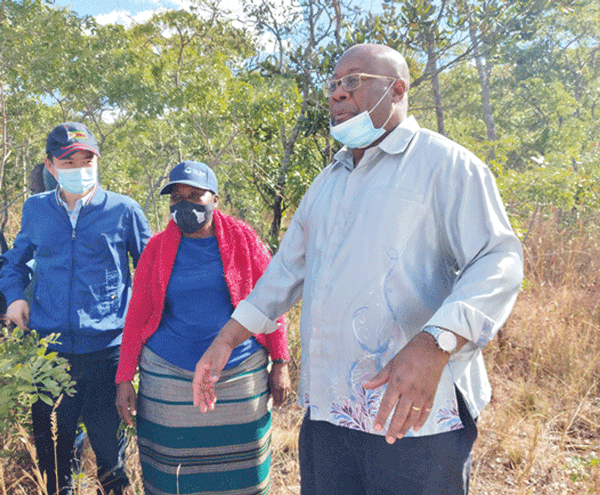
BY Freeman Makopa THROUGH Tsingshan Investments Zimbabwe, Tsingshan Holding Group, the world’s largest stainless steel and nickel producer has kick-started the development of the country’s new integrated steel operation following the collapse of ZiscoSteel.
In this interview, Benson Xu (BX), chief executive officer of the local operation, tells NewsDay (ND) Business reporter Freeman Makopa his plan for Zimbabwe. Below are excerpts of their discussion…
ND: Can you start by detailing Tsingshan Holdings Group’s investments.
BX: Tsingshan Holdings Group is the world’s largest stainless steel and nickel producer. The company has production bases in China, Indonesia, India, US and in Zimbabwe. It has built a 150 000 tonne per year ferrochrome plant in Selous, Chegutu district and a 350 000 tonne per year coke plant in Hwange and is currently constructing a US$1,5 billion Dinson Iron and Steel Plant in Mvuma/ Chivhu. In June 2018, Tsingshan Holdings and the Zimbabwean government signed a memorandum of understanding to build the steel plant. We want to value-add chrome ore to produce ferrochrome, to value-add coal to produce metallurgy coke, to value-add iron ore to produce carbon steel and to beneficiate mineral resources in Zimbabwe to achieve a stainless steel ecosystem.
ND: When did construction of the Mvuma plant begin?
BX: We commenced constructing the steel plant in June 2021. Dinson has since applied for Special Economic Zone status for its value-addition integrated iron and steel industrial park. In the integrated iron and steel industrial park there will be a steelmaking plant, rolling mill, coke plant, ferrochrome plant, power plant, new energy equipment plant and a supporting business centre. The Dinson steel industrial park will have an annual turnover of US$2 billion for both export and domestic markets. A concept master plan for the new town is now in place. This investment will go a long way in ensuring Zimbabwe’s economic growth take-off.
ND: What is the plant’s production capacity?
BX: The plant will produce 1,2 million metric tonnes (mt) of pig iron and carbon steel per year. This will see the consumption of 500 000mt per year of ferrochrome and one million mt per year of coke, which we will also produce in Zimbabwe through our sister companies Afrochine Smelting and Dinson Colliery.
- Chamisa under fire over US$120K donation
- Mavhunga puts DeMbare into Chibuku quarterfinals
- Pension funds bet on Cabora Bassa oilfields
- Councils defy govt fire tender directive
Keep Reading
ND: Tell us the benefits of the project.
BX: The real value of iron and steel to society is not only measured in the tonnes we produce or dollars, but in terms of industrial growth attached to the sector, the technological development it brings to the country, the economic pillars it supports within the country and worldwide and the value chain it commands in industrial development. This project will reduce the import bill on finished steel and it is a major booster to coke and ferrochrome production in Zimbabwe. Zimbabwe will be Africa’s largest mineral refining cluster and leading steel producer in Africa. There will be development of industrial parks, roads, rail, dams, a new town and it will bring urbanisation in Manhize (in Chivhu). A total revenue of US$5 billion will be generated with tax revenue of US$300 million.
ND: Does Zimbabwe have enough steel for such as massive operation?
BX: Iron and steel companies are importing 90% of key steel raw materials for their steelworks. Therefore, opening of the plant will close the gap of steel deficiency in Zimbabwe.
ND: Talk about the iron ore mineral resource reserves, do we have enough?
BX: Zimbabwe is a mineral-rich country endowed with over 48 minerals including gold, platinum group metals, diamonds, coal, gemstones, granite, manganese, chrome, lithium, asbestos, iron ore, copper, nickel, cobalt, limestone, coal-bed methane and rare earth minerals. We are doing our mining along the Great Dyke along Mwanesi Range, which represents one of the largest iron ore reserves in Zimbabwe and in the world having estimated reserves of 45 billion tonnes of grading 43% iron metal. We need more than 200 years to exhaust the iron ore in Zimbabwe. With our geological survey results, the investment in Manhize is worthwhile and it’s a huge benefit to the country.
ND: How would you compare your production vis-à-vis Zisco in the old days?
BX: Production will be twice more than the then Zisco and most of the steel players in this country. Yes, there are major players worldwide, but we are there among the big players.
- Follow us on Twitter@NewsDayZimbabwe










